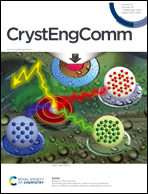A new process for the stabilization of vertically aligned GdB6 nanorods and their field emission properties†
Abstract
Display devices and electron-emitting materials based on rare-earth hexaborides have attracted considerable research interest due to chemical inertness and low work function. These properties make them perfect materials for field emission. Here, a low-temperature process for the stabilization of GdB6 nanorods using Gd(OH)3 nanorods and NaBH4 has been designed. The synthesis of a gadolinium hydroxide precursor was done via a hydrothermal route at 120 °C. Further, the as-obtained ultrafine nanorods of Gd(OH)3 were mixed with sodium borohydride and annealed at 1000 °C in an inert atmosphere at a slow heating rate (40 °C h−1). Transmission electron microscopy (TEM) results of GdB6 showed the formation of ultrafine nanorods (40 nm × 150 nm). Interestingly, we have observed the formation of a rod-like morphology of GdB6 because of the slow heating rate (40 °C h−1) employed during the annealing process. Furthermore, the GdB6 film was fabricated on Si-substrate using ultrafine GdB6 nanorods via a spin coating method. The atomic force microscopy (AFM) study of the GdB6 film showed the presence of vertically aligned GdB6 nanorods. The field emission study of the vertically aligned GdB6 nanorods showed low turn-on field (4.4 V μm−1) and high enhancement factor (β = 1490).



 Please wait while we load your content...
Please wait while we load your content...